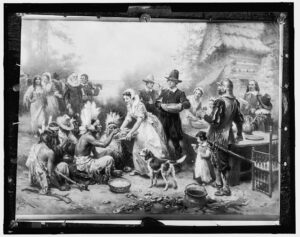
The Journey of the Pilgrims
In 1620, a group of English Separatists known as the Pilgrims boarded a ship called the Mayflower and sailed to the New World. They were seeking religious freedom because they wanted to worship without fear of being punished for their beliefs. The Pilgrims arrived in what is now Plymouth, Massachusetts, where they founded the Plymouth Colony. Their first years were extremely difficult, filled with harsh winters, sickness, and not enough food or supplies.
At first, the Pilgrims had a shaky relationship with the Native Americans, but things improved over time, especially thanks to the help of the Wampanoag tribe and their leader, Squanto. Squanto played a crucial role by teaching the Pilgrims how to grow crops, catch fish, and gather food, which helped them survive.
William Bradford: A Key Leader
William Bradford was a significant leader in the early years of the Plymouth Colony. He served as the governor for more than 30 years, from 1621 until his death in 1657. Bradford was one of the Pilgrims who traveled on the Mayflower, looking for a new life and religious freedom.
He is well-known for his detailed journal, “Of Plymouth Plantation,” which is one of the most important historical documents from that time. This journal provides a firsthand account of the Pilgrims’ experiences, from their challenging voyage across the Atlantic to their struggles in establishing a new community in the harsh wilderness of New England. In his journal, Bradford wrote about the difficulties the Pilgrims faced, including severe winters, illness, and conflicts with Native American tribes.
The First Thanksgiving: A Moment of Unity
One important event described in Bradford’s journal happened in the fall of 1621. The Pilgrims celebrated their first successful harvest with a feast that included members of the Wampanoag tribe. This event is known as the first Thanksgiving and is often seen as a symbol of cooperation and unity between different cultures.
During the feast, the Pilgrims and the Wampanoag shared foods such as corn, beans, squash, venison, and seafood. The celebration lasted for three days and was a time of joy and gratitude. However, it’s essential to remember that the relationship between the Pilgrims and Native Americans was not always peaceful, and tensions did arise in the Plymouth Colony.
The Mayflower Compact: A Step Toward Democracy
Before leaving the Mayflower, the Pilgrims created the Mayflower Compact, a document that established a self-governing body for their colony. This compact is considered an early example of democratic ideas that would influence American society and government in the future. Self-governance means that the people in the colony would make their own rules and decisions together, much like how a classroom might have rules decided by the students.
The Pilgrims’ commitment to self-governance and religious freedom helped lay the groundwork for the values of liberty and democracy that are celebrated in America today.